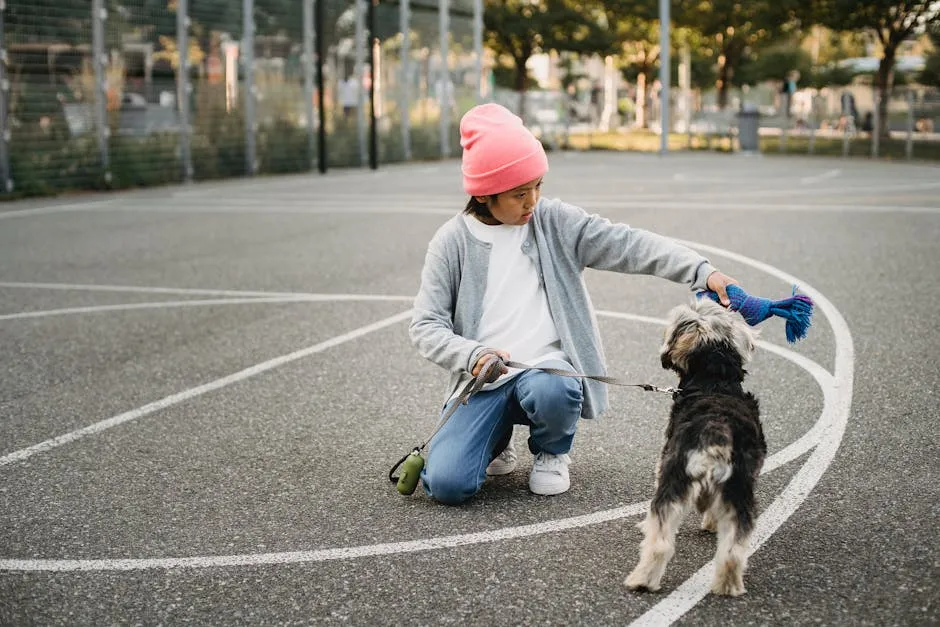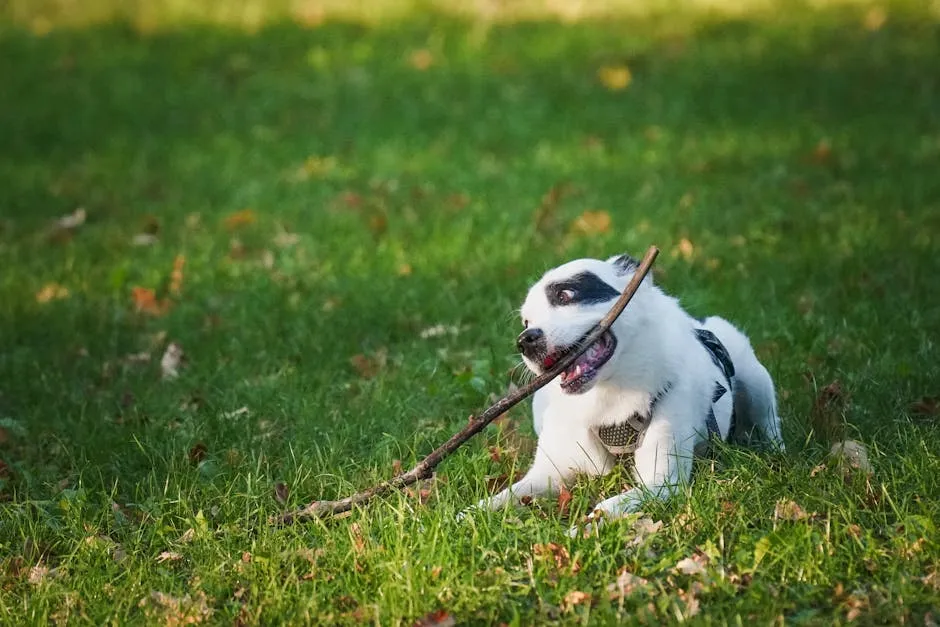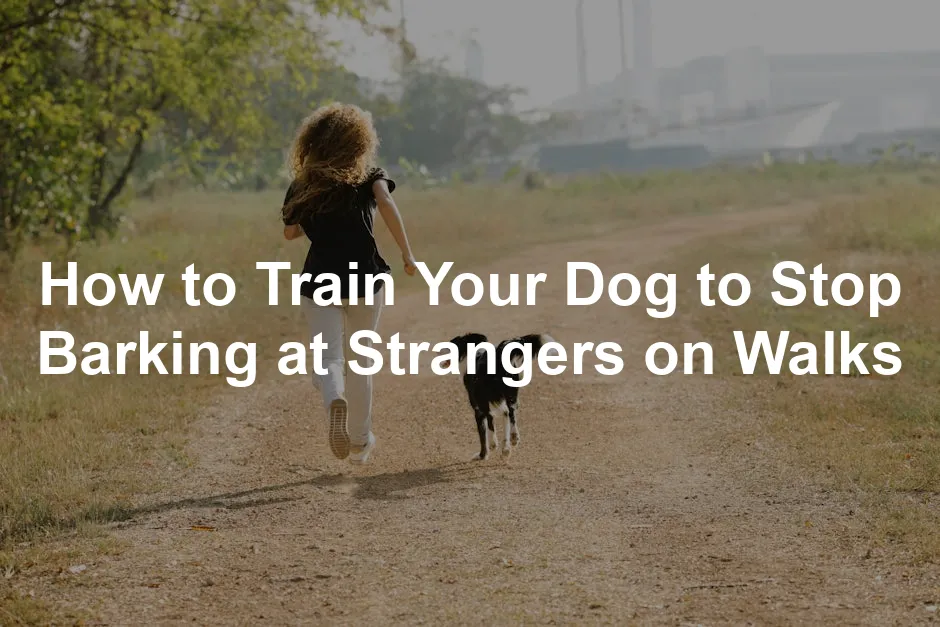How to Train Your Dog to Stop Barking at Strangers on Walks
Introduction
Barking is a natural way for dogs to communicate. However, barking at strangers during walks can be stressful. This behavior can affect your dog’s wellbeing and your comfort. Addressing it is essential for peaceful outings together.
One great way to reward your pup during training is with Dog Training Treats. These tasty morsels can make your dog feel like a champion every time they follow your command, and who doesn’t love a good snack?

Summary and Overview
Understanding why dogs bark at strangers is key. It helps you manage this behavior effectively. Excessive barking can impact social interactions and daily walks. It can also lead to frustration for both you and your dog. The main goal of this article is to share practical training methods. You will find tips to reduce your dog’s barking and promote calm behavior. Remember, patience and consistency in training are crucial. Positive reinforcement will yield the best results over time.
For effective strategies on training your dog, consider exploring effective training methods for rescue dogs with anxiety in the home environment.
Understanding Why Dogs Bark at Strangers
Reasons for Barking
Dogs bark at strangers for various reasons. One common reason is territorial instincts. Many dogs see unfamiliar people as a threat to their space. Another reason is fear and anxiety. Dogs lacking socialization may react by barking when they feel uneasy.

Over-excitement is a third reason. Some dogs bark out of sheer joy when they see new faces. Finally, a lack of proper socialization can lead to barking. Dogs that haven’t been exposed to different people may react negatively.
To keep their excitement in check, consider using a Dog Training Clicker. This nifty device helps communicate your commands to your furry friend, making training sessions more effective and fun!
The Role of Body Language
Paying attention to your dog’s body language is vital. Signs of nervousness include a tucked tail or raised hackles. If your dog appears relaxed with a wagging tail, they might just be excited. Understanding these cues helps you gauge their feelings. This insight can guide your training approach effectively.
Best Practices for Training
Consistency is Key
When it comes to training your dog, consistency is vital. Use the same commands and cues every time. This helps your dog learn what you expect. For example, if you say “quiet,” always use that term instead of switching to “hush” or “stop.”

Establishing a routine for training sessions is also crucial. Set aside specific times each day for training. Short, frequent sessions work best. This keeps your dog engaged and focused. Aim for about 5-10 minutes a day. Consistency helps reinforce learned behaviors over time.
Consider using a Dog Training Book: “The Art of Raising a Puppy” by the Monks of New Skete. This book is a goldmine of information for dog owners, providing insights and techniques that can transform your furry friend into a well-behaved companion.
Positive Reinforcement Techniques
Positive reinforcement is a powerful tool in dog training. It involves rewarding your dog for good behavior. Use treats and praise effectively to encourage your dog. When your dog remains quiet around strangers, immediately reward them with a treat.
High-value treats play a significant role in effective training. These are special treats your dog loves, like small pieces of chicken or cheese. Save these for training sessions, making your dog more eager to respond. The more motivated they are, the quicker they’ll learn. Consider using a Dog Treats for Training to keep your pup motivated and excited!

Gradual Desensitization
Gradual desensitization is essential for helping your dog adjust to strangers. Start by exposing your dog to strangers from a distance where they feel safe. If your dog starts barking, you’re too close. Slowly decrease this distance over time.
During training, manage the distance carefully. If your dog remains calm, reward them with treats. This creates positive associations with strangers. Over time, your dog will learn to stay quiet and relaxed. The key is to take it slow and be patient.
Effective Training Techniques
The Quiet Command
Teaching your dog the “quiet” command can be very effective. Start by allowing them to bark a few times. Then, gently hold their muzzle and calmly say, “quiet.” Timing is critical here. The moment they stop barking, reward them with a treat.

Repeat this process, gradually increasing the time they need to stay quiet before receiving a reward. Consistency in this technique will help your dog learn what “quiet” means. Over time, they will respond to the command without needing to hold their muzzle.
Distraction Techniques
Distractions can be a great tool to redirect your dog’s attention when they start barking. Use items like shaking keys or Squeaky Dog Toys to capture their focus. When your dog looks at the distraction, immediately give the command to “sit.”
Once they obey, reward them with a treat. This teaches your dog that there are better options than barking. You can also use distractions during walks. If a stranger approaches, turn your dog’s attention elsewhere and reward their calmness.
Incorporating distractions into your training plan keeps it engaging and fun. This method not only reduces barking but also strengthens your bond with your dog. With time and practice, your dog will learn to focus on you instead of strangers.
Teaching a “Spot” Command
Teaching your dog a “spot” command can work wonders. This command directs your dog to a designated area when they see a stranger. Start by choosing a comfortable spot, like a mat or bed. Use a command like “go to your spot.” When your dog goes to the spot, reward them with a treat. Repeat this several times, so they associate the command with the action.

Once your dog understands the command, practice it during walks. When encountering a stranger, use the command. If your dog goes to their spot, reward their calm behavior. This method reinforces positive actions and helps your dog feel secure.
Redirecting Attention During Walks
Redirecting your dog’s attention is crucial when you encounter strangers. Carry high-value treats on walks. When they see someone unfamiliar, use their name to grab their attention. Show them the treat, and say, “look.” This helps shift their focus away from barking.
Once your dog looks at you, issue a command like “sit” or “stay.” Reward them when they comply. This technique reinforces good behavior instead of barking. Consistently practicing this will help your dog learn to focus on you, creating a calmer walking experience.
Practice Sessions
Regular practice sessions are essential for effective training. Short, frequent sessions work best. Aim for 5 to 10 minutes daily, keeping your dog engaged. This approach prevents boredom and reinforces learning.

You can also set up practice scenarios. Invite friends over to simulate encounters with strangers. This allows your dog to practice their responses in a controlled environment. Gradually increase the difficulty by having friends act like strangers. Reward your dog for calm behavior during these sessions. This method enhances their social skills and builds confidence.
Managing the Environment
Preventive Measures
Managing your dog’s exposure to strangers can significantly reduce barking. Start by limiting their visibility. Closing curtains or blinds when you’re home can help. This prevents your dog from reacting to passersby.

Create a calm space for your dog to retreat when guests arrive. This area should be quiet and comfortable, away from noise. Consider using White Noise Machines for Dogs or calming music to mask outside sounds. This helps your dog feel secure and relaxed.
Another effective measure is to prepare your dog for visitors. If you know someone is coming over, give your dog a heads-up. This can help them stay calm when the doorbell rings. Gradual exposure to new people can also make a difference. Regularly inviting friends over helps your dog associate strangers with positive experiences.
Exercise and Mental Stimulation
Regular exercise is vital for reducing anxiety in dogs. Dogs with pent-up energy often bark more. A daily routine of walks, playtime, and outdoor activities helps keep your dog calm. Aim for at least 30 minutes of physical activity each day.

Incorporating mental stimulation is equally important. Engage your dog’s mind with Dog Puzzle Toys or interactive games. Activities like hide-and-seek can be fun. Training sessions are another great way to challenge your dog mentally. Teaching new tricks or commands strengthens your bond while keeping their mind active.
Consider socializing your dog with other dogs and people. This exposure can help reduce fear and anxiety. By providing ample exercise and mental challenges, you’ll promote a more relaxed demeanor. This can lead to quieter walks and a happier dog overall.
Conclusion
Training your dog to stop barking at strangers takes time and effort. Remember, patience and consistency are key. With the right techniques, you can teach your dog to remain calm during walks. If needed, don’t hesitate to seek help from a professional trainer. Keep practicing to ensure continued improvement. Your efforts will lead to more enjoyable outings together.
FAQs
Why does my dog bark at strangers?
Dogs bark at strangers for several reasons. One reason is territorial instinct. When a stranger approaches, your dog may see them as a threat. This behavior often signals a protective nature. Another reason can be fear or anxiety. Dogs that lack socialization may not know how to react. They might bark to express discomfort. Lastly, some dogs bark out of excitement. This enthusiastic barking usually isn’t harmful but can still be startling to others. Understanding these triggers is crucial in addressing barking behavior.
How long will it take to train my dog to stop barking?
Training time varies significantly among dogs. Factors like age, breed, and temperament play a role. For some dogs, noticeable improvements may occur within weeks. Others might take months to adjust their barking behavior. Your consistency as an owner is crucial as well. Regular practice aids in reinforcing learned behaviors. The more consistent you are with commands and rewards, the quicker your dog will grasp the concepts. Remember, patience is essential. Celebrate small victories along the way to keep both you and your dog motivated.
Are there any quick fixes for barking?
Many people hope for quick fixes to stop barking. Unfortunately, there are no instant solutions. Common misconceptions suggest that a simple command or device will work. However, effective training takes time and effort. Quick fixes often lead to temporary results, leaving the underlying issues unaddressed. It’s essential to focus on consistent training strategies. Building trust and understanding with your dog will yield better long-term results. Remember, barking is a natural behavior. Addressing it requires a thoughtful approach rather than a quick, one-time fix.
What should I do if my dog becomes aggressive while barking?
If your dog shows aggression while barking, take it seriously. Aggressive barking can stem from fear or territorial instincts. First, ensure safety for yourself and others. If the aggression escalates, seek professional help. A dog trainer or behaviorist can provide guidance tailored to your dog’s needs. Meanwhile, avoid putting your dog in situations that trigger aggressive responses. Managing your dog’s environment is vital until you resolve these issues. Gradually working on desensitization techniques can also help, but always prioritize safety first.
Can barking at strangers be completely eliminated?
Completely eliminating barking at strangers is unrealistic for most dogs. Barking is part of their natural communication. Instead of aiming for total silence, focus on reducing excessive barking. Set realistic expectations based on your dog’s personality and history. Some dogs may always bark occasionally, especially when excited. The goal should be to manage the barking effectively. With patience and training, you can significantly decrease their barking while fostering better behavior around strangers. Celebrate progress, no matter how small.
Should I use a muzzle or bark collar?
Using a muzzle or bark collar should be a last resort. These tools can sometimes mask the problem without addressing the root cause. Instead, focus on positive training methods that promote better behavior. Muzzles may be appropriate in specific situations, like vet visits, but they should not be a permanent solution. Bark collars can cause stress and anxiety, potentially worsening the behavior. Prioritize building trust and understanding with your dog. Positive reinforcement techniques are much more effective and lead to lasting change.
When should I consider professional training help?
Professional training help may be necessary if you notice persistent issues. If your dog’s barking becomes overwhelming or aggressive, seeking expert guidance is wise. Consider reaching out when you feel unsure about training techniques. Signs of stress or fear in your dog can also indicate the need for professional support. Additionally, if you’ve tried various methods without success, a trainer can provide new perspectives. Collaborating with a professional ensures you’re on the right path for your dog’s behavior modification journey.
To ensure your dog is well-prepared for any situation, consider investing in a Dog First Aid Kit. It’s a must-have for every dog owner, ensuring you’re ready for any unexpected mishaps!
Please let us know what you think about our content by leaving a comment down below!
Thank you for reading till here 🙂
All images from Pexels





